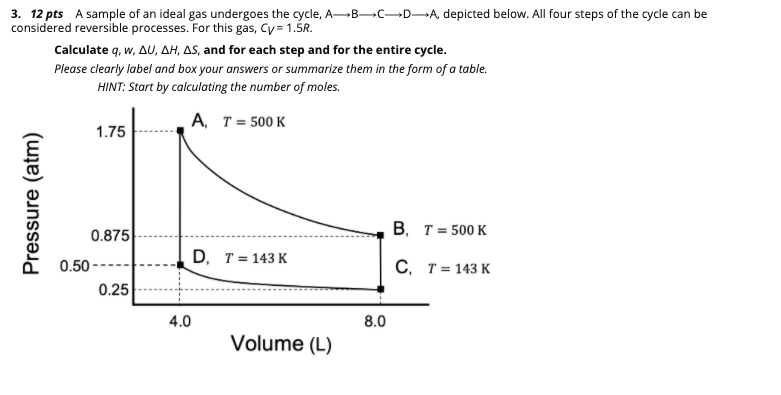A sample of an ideal gas undergoes the cycle A to B to C to D to A. depicted below. All four steps of the cycle can be considered reversible processes. For this gas, Cv=1.5R. There are no properities of gas here. All the information is provided on the graph. Calculate q, w, deltaU, deltaH, deltaS for each step and for the entire cycle. Please clearly label and box your answers in the form of a table.
A sample of an ideal gas undergoes the cycle A to B to C to D to A. depicted below. All four steps of the cycle can be considered reversible processes. For this gas, Cv=1.5R. There are no properities of gas here. All the information is provided on the graph. Calculate q, w, deltaU, deltaH, deltaS for each step and for the entire cycle. Please clearly label and box your answers in the form of a table.
Principles of Modern Chemistry
8th Edition
ISBN:9781305079113
Author:David W. Oxtoby, H. Pat Gillis, Laurie J. Butler
Publisher:David W. Oxtoby, H. Pat Gillis, Laurie J. Butler
Chapter13: Spontaneous Processes And Thermodynamic Equilibrium
Section: Chapter Questions
Problem 39P
Related questions
Question
A sample of an ideal gas undergoes the cycle A to B to C to D to A. depicted below. All four steps of the cycle can be considered reversible processes. For this gas, Cv=1.5R. There are no properities of gas here. All the information is provided on the graph.
Calculate q, w, deltaU, deltaH, deltaS for each step and for the entire cycle. Please clearly label and box your answers in the form of a table.
Hint: Start by calculating the number of moles

Transcribed Image Text:3. 12 pts A sample of an ideal gas undergoes the cycle, AB→C-DA, depicted below. All four steps of the cycle can be
considered reversible processes. For this gas, Cy = 1.5R.
Calculate q, w, AU, AH, AS, and for each step and for the entire cycle.
Please clearly label and box your answers or summarize them in the form of a table.
HINT: Start by calculating the number of moles.
А, Т3D 500 K
1.75
В. Т%3D 500 K
0.875
D, T= 143 K
0.50-
С. Т%3 143 К
0.25
4.0
8.0
Volume (L)
Pressure (atm)
Expert Solution
This question has been solved!
Explore an expertly crafted, step-by-step solution for a thorough understanding of key concepts.
Step by step
Solved in 2 steps with 13 images

Knowledge Booster
Learn more about
Need a deep-dive on the concept behind this application? Look no further. Learn more about this topic, chemistry and related others by exploring similar questions and additional content below.Recommended textbooks for you

Principles of Modern Chemistry
Chemistry
ISBN:
9781305079113
Author:
David W. Oxtoby, H. Pat Gillis, Laurie J. Butler
Publisher:
Cengage Learning

Physical Chemistry
Chemistry
ISBN:
9781133958437
Author:
Ball, David W. (david Warren), BAER, Tomas
Publisher:
Wadsworth Cengage Learning,

Chemistry: Principles and Practice
Chemistry
ISBN:
9780534420123
Author:
Daniel L. Reger, Scott R. Goode, David W. Ball, Edward Mercer
Publisher:
Cengage Learning

Principles of Modern Chemistry
Chemistry
ISBN:
9781305079113
Author:
David W. Oxtoby, H. Pat Gillis, Laurie J. Butler
Publisher:
Cengage Learning

Physical Chemistry
Chemistry
ISBN:
9781133958437
Author:
Ball, David W. (david Warren), BAER, Tomas
Publisher:
Wadsworth Cengage Learning,

Chemistry: Principles and Practice
Chemistry
ISBN:
9780534420123
Author:
Daniel L. Reger, Scott R. Goode, David W. Ball, Edward Mercer
Publisher:
Cengage Learning

Chemistry
Chemistry
ISBN:
9781305957404
Author:
Steven S. Zumdahl, Susan A. Zumdahl, Donald J. DeCoste
Publisher:
Cengage Learning


Chemistry: An Atoms First Approach
Chemistry
ISBN:
9781305079243
Author:
Steven S. Zumdahl, Susan A. Zumdahl
Publisher:
Cengage Learning